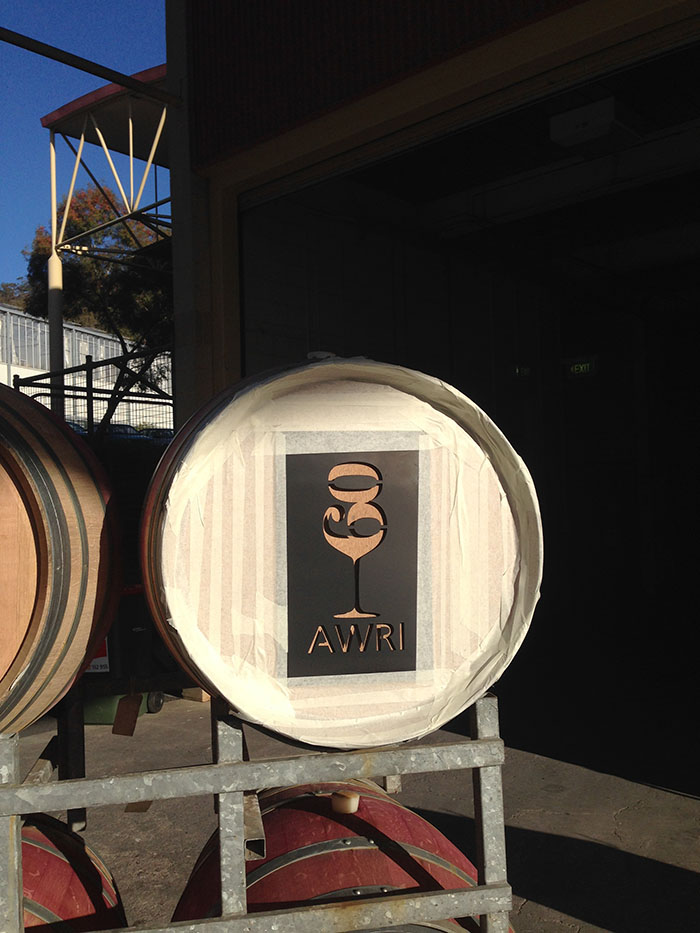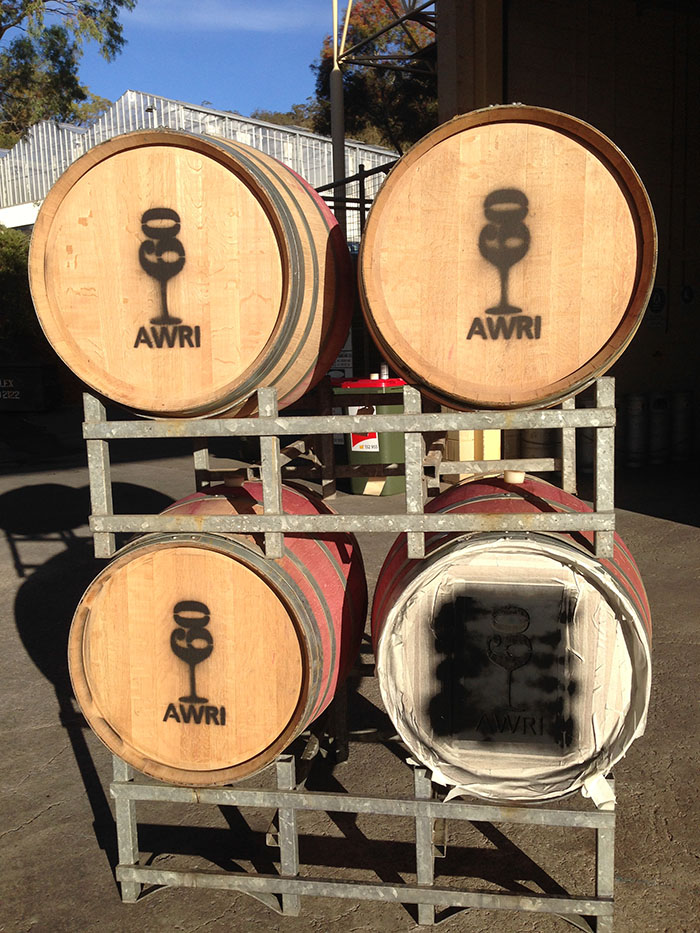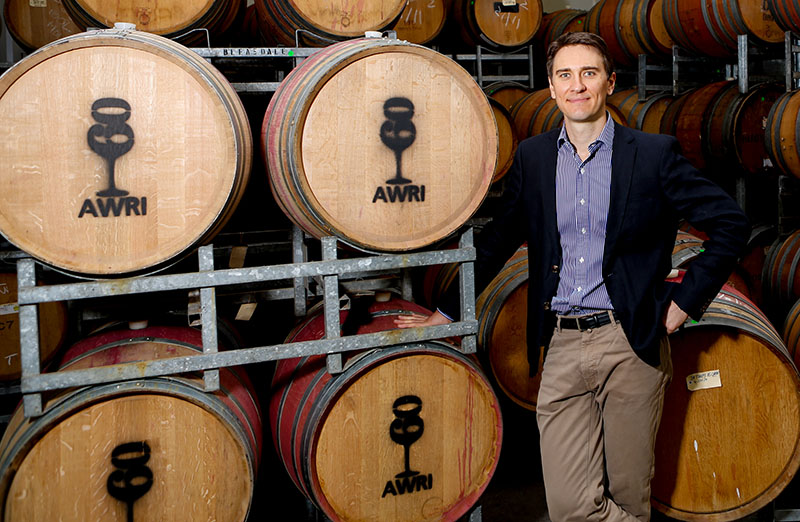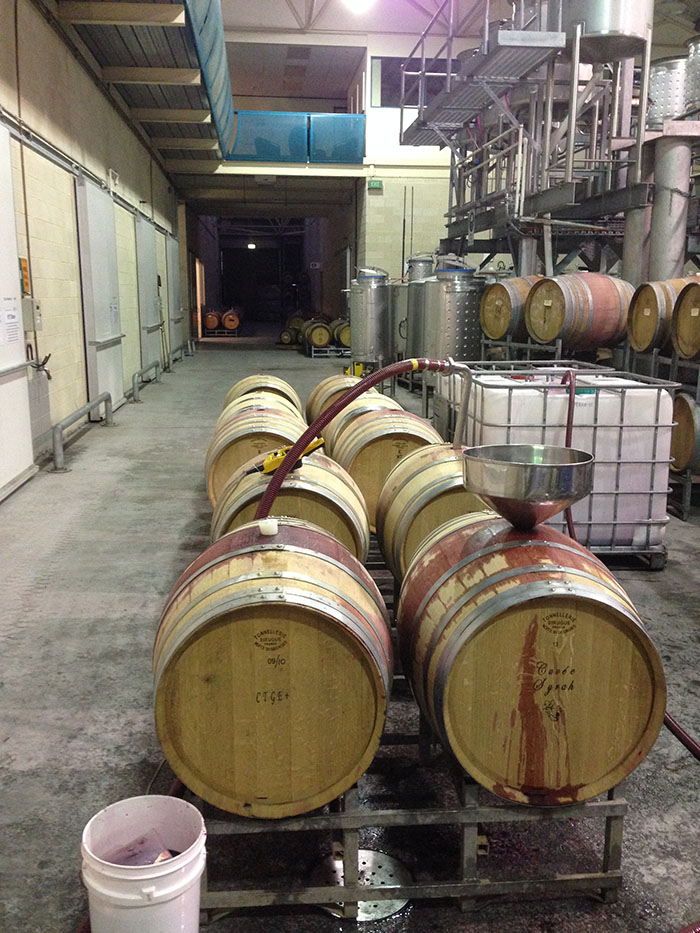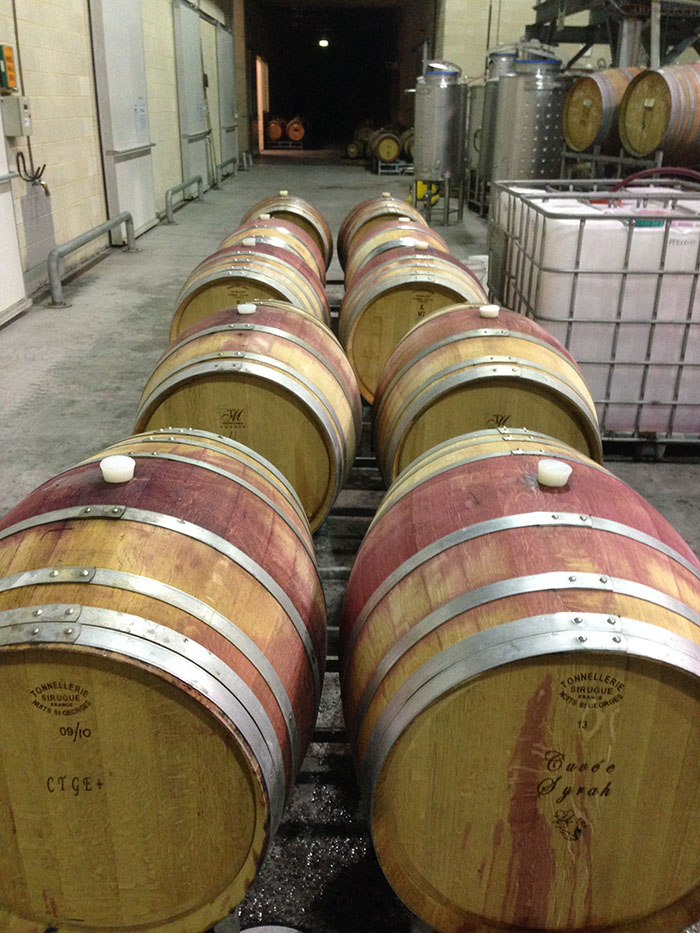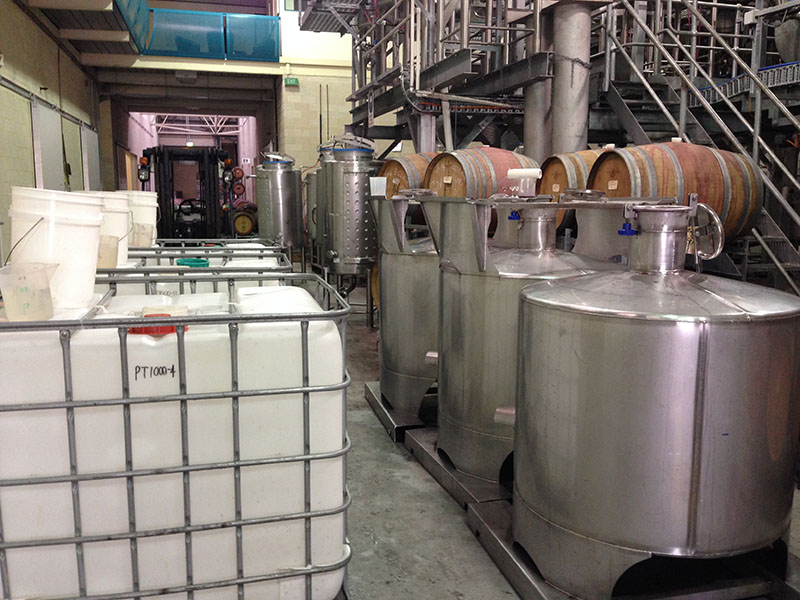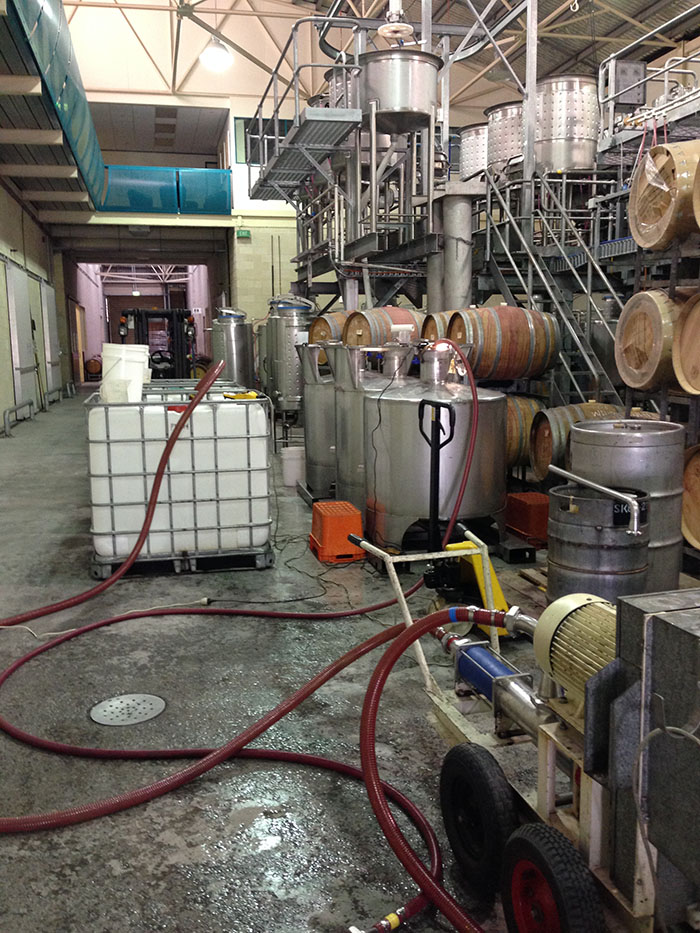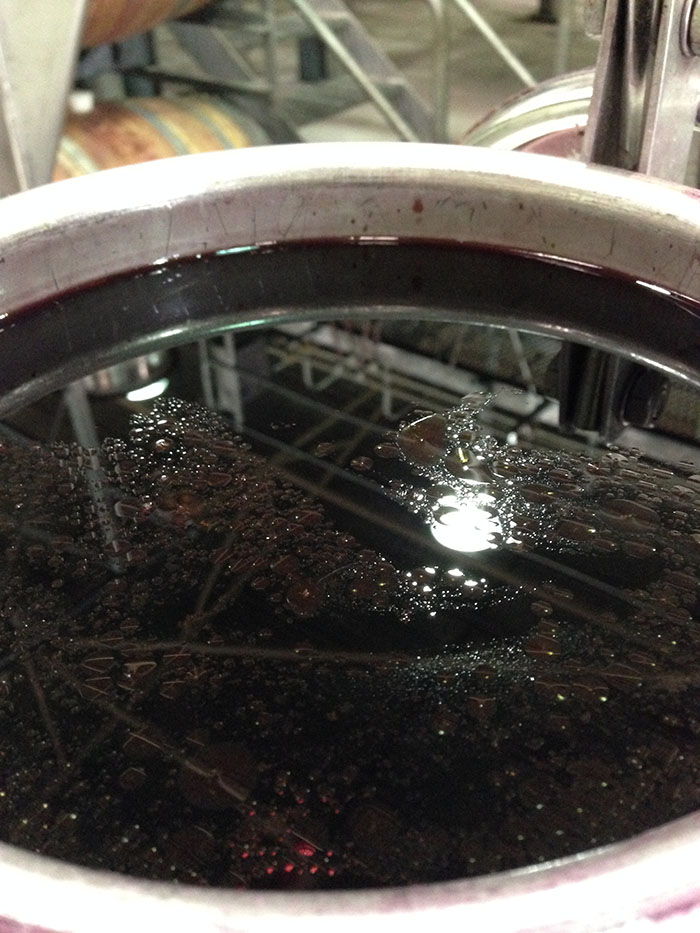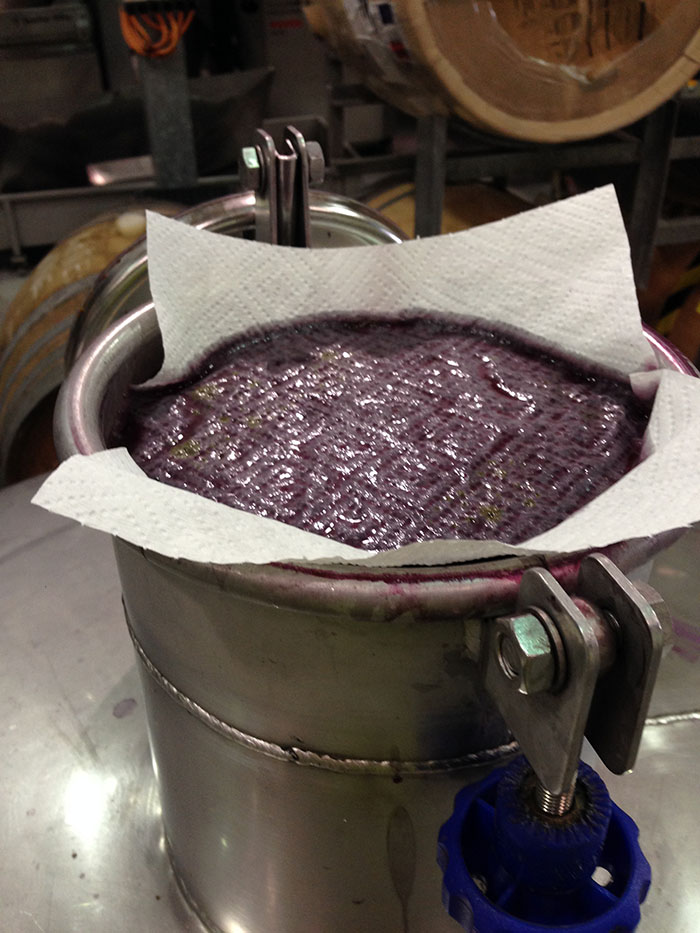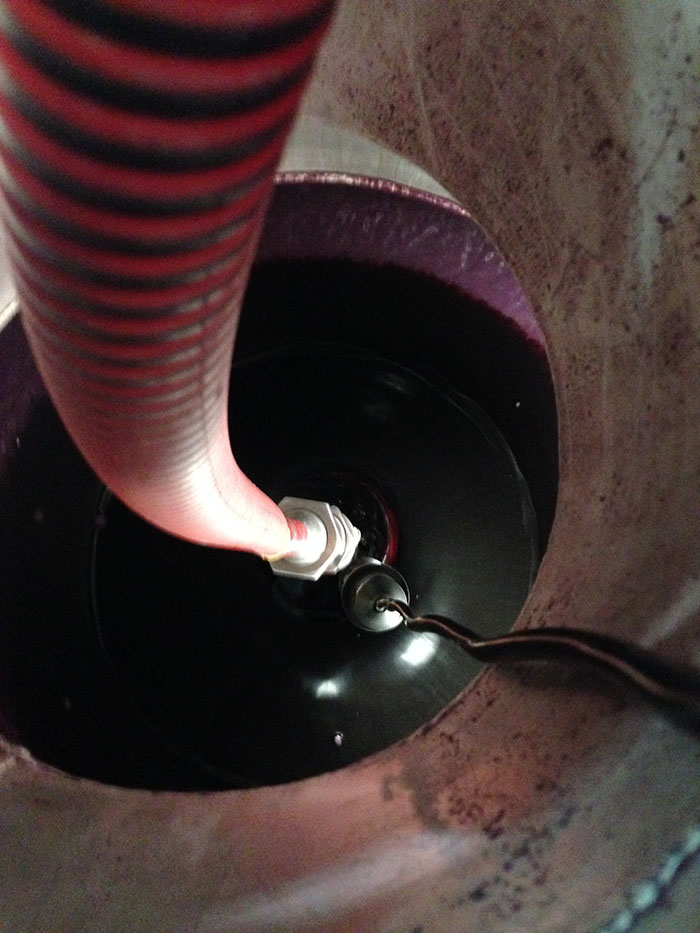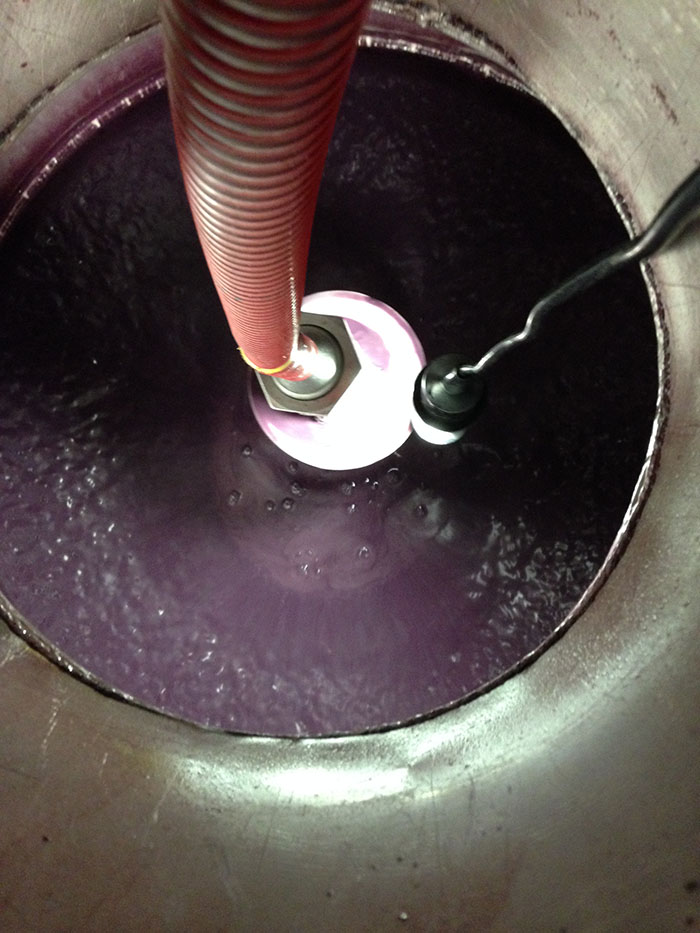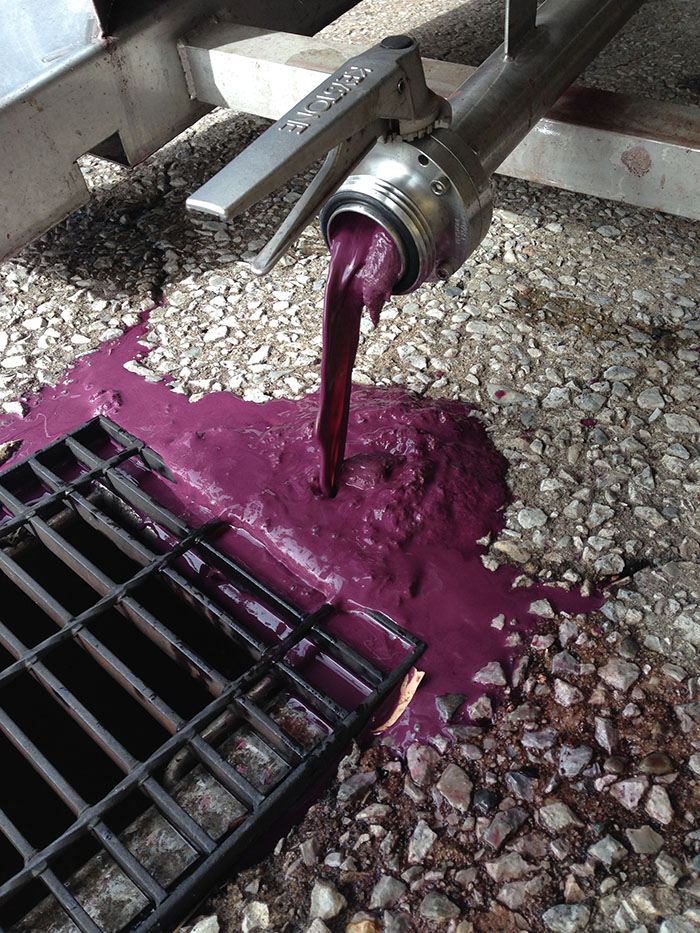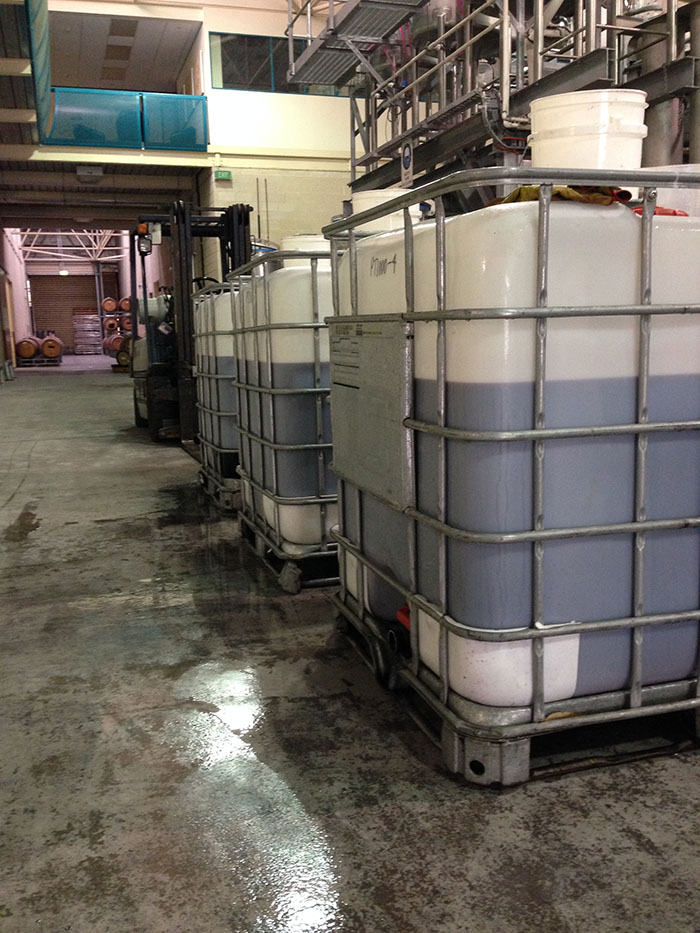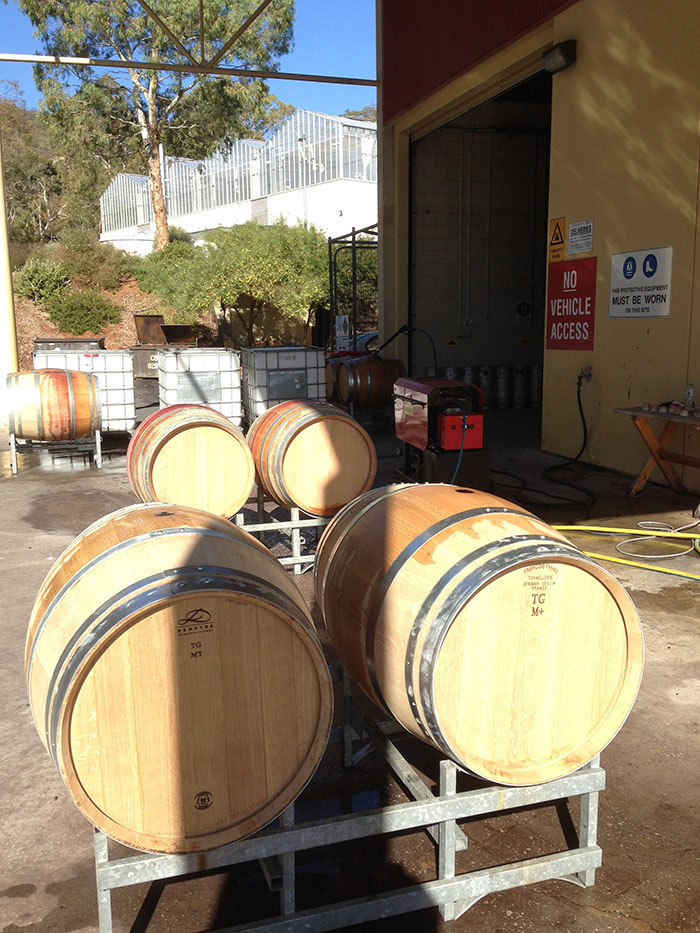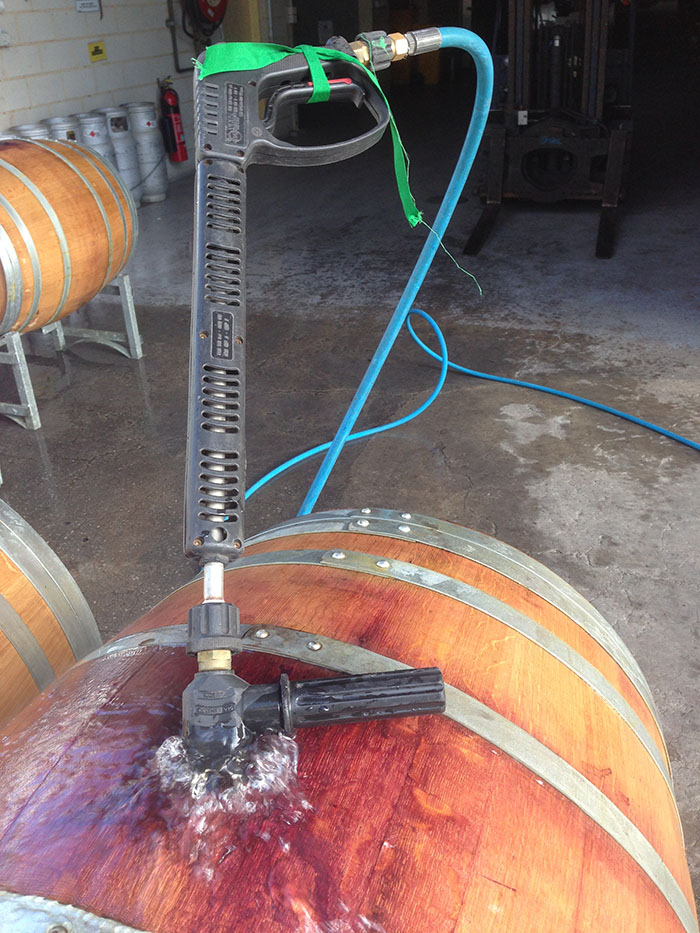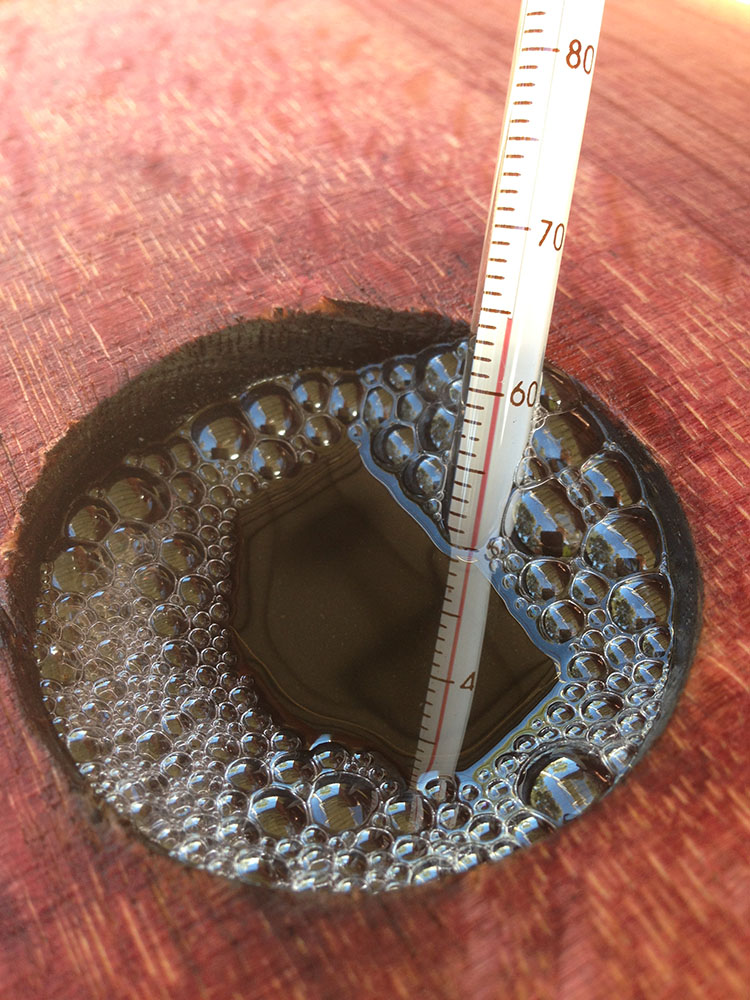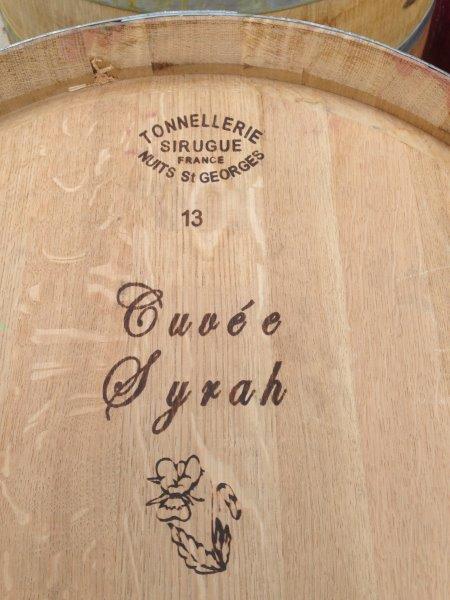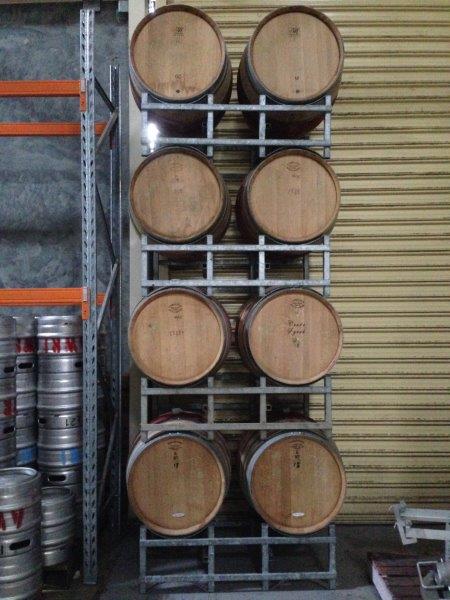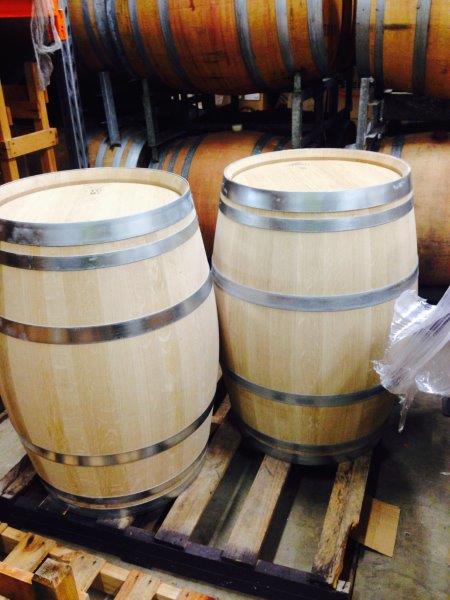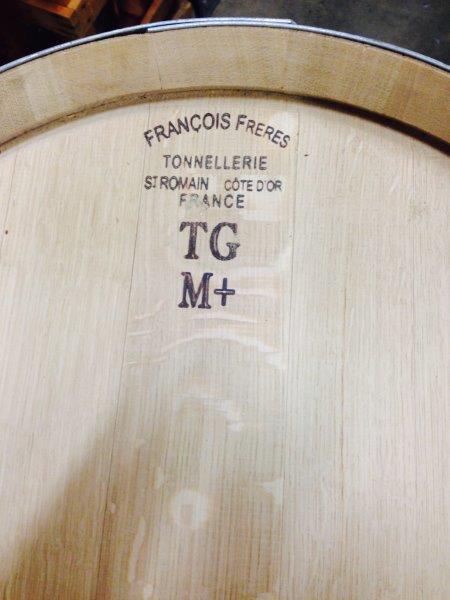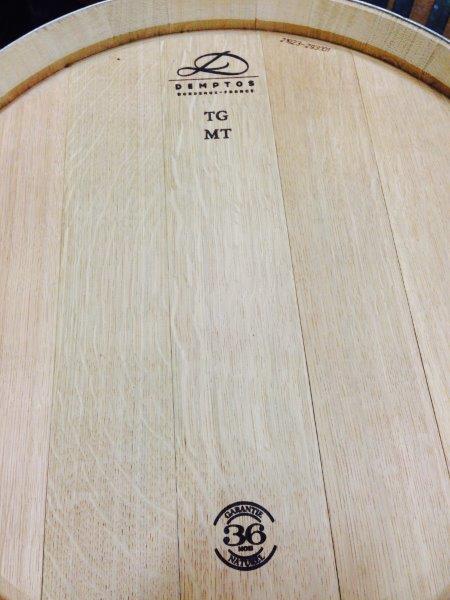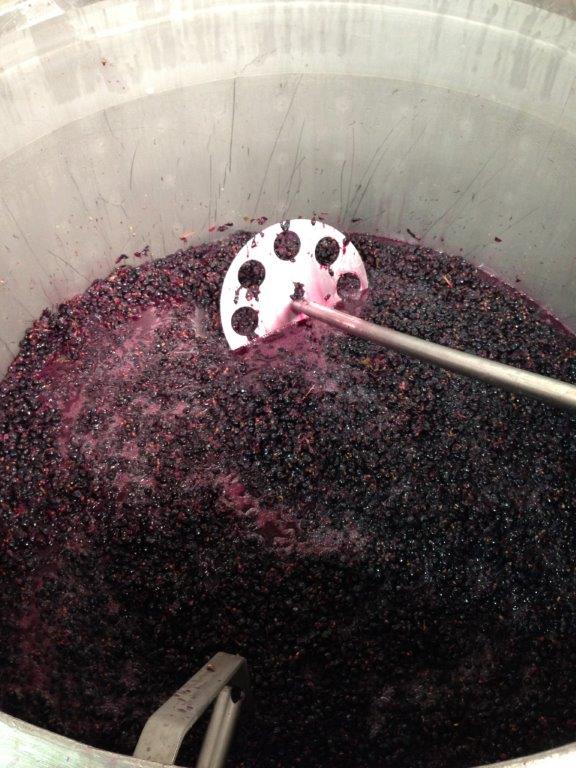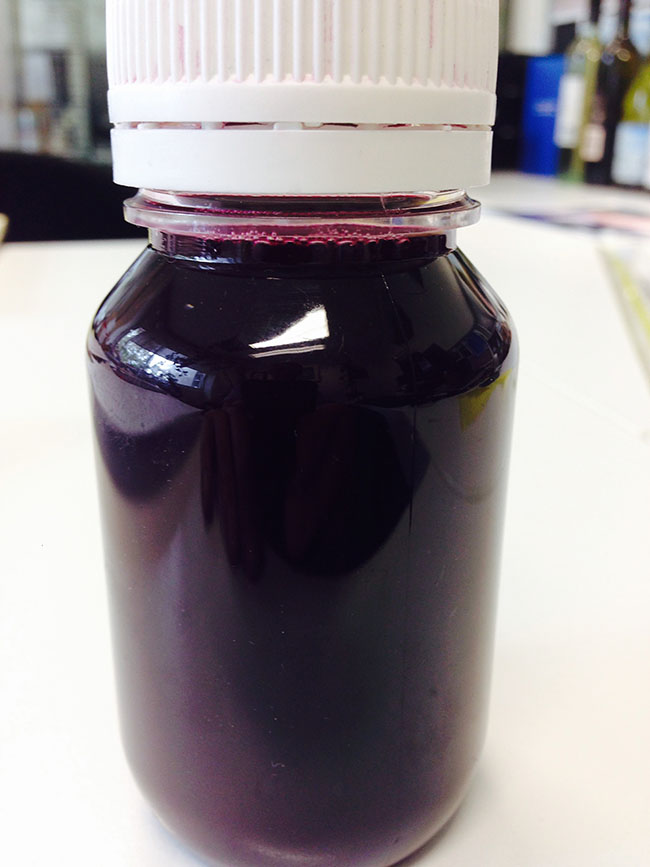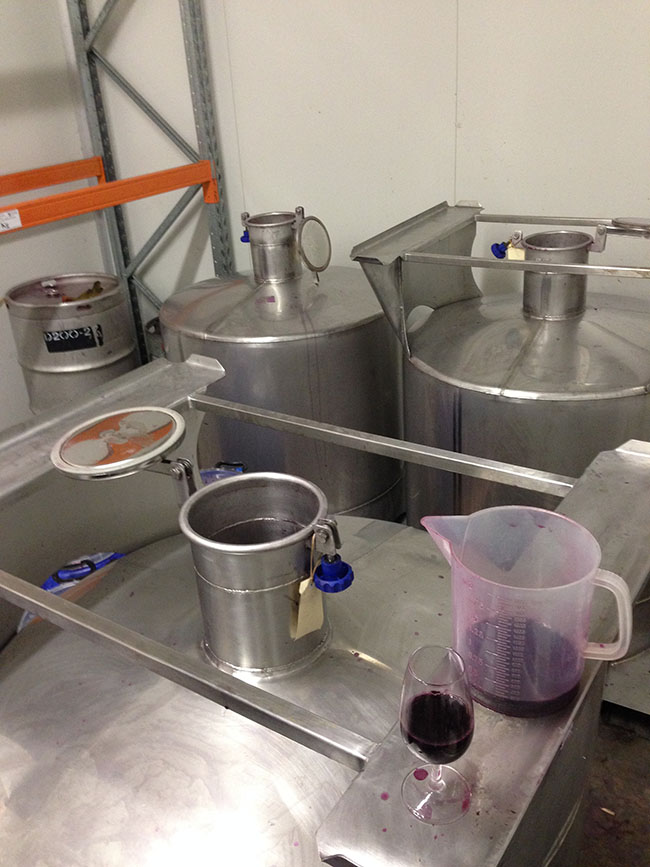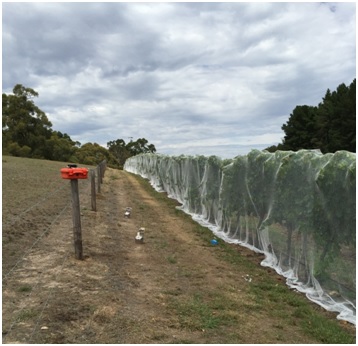In such a busy winery, with so many students, researchers and other winemaking groups doing their own thing, it is certainly in your own interest to make sure that your barrels are clearly labelled. We also have what we think is a really good logo to mark our 60th birthday, so we decided to use it to avoid any doubt of what was in our barrels!
The Australian Wine Research Institute Blog
Into the barrels
12 April 2015 >By early evening it was finally time to put the wine into barrels. Working with barrels is a very satisfying thing for this winemaker.
The wine had retained great colour after additions of 65 ppm of SO2 and some tartaric acid.
And while filling the barrels, we were pleased to be visited by Caroline Winter of the ABC Country Hour program, who had come across this blog on the internet. Her program about the wine should air shortly.
Ten barrels safely put to bed.
Time to blend
>Because there was no tank available which was large enough to blend all of our wine, the three tanks and two smaller containers had to be accurately blended by other means, before being put into barrel.
Here’s something we haven’t seen very often – grape seed oil on top of the wine.
After the initial horror, before it was realised what it was, it is easily removed with a piece of kitchen towel.
The wine had settled well and racked very cleanly.
And the lees were very thick and gluggy.
So we had an accurate blend for the first time, and geez – we reckon the wine is looking pretty good.
Barrel preparation
11 April 2015 >It was time to get the wine into oak, with the malo having been completed very efficiently in tank. But the barrels were given a heat treatment first.
They were filled with water, which was then brought up to temperature by blowing hot water/steam from a pressure cleaner through it.
This raised the temperature to almost 65 degrees quite rapidly, and it was then left overnight; long enough for the radiated heat to kill any pesky Bretts or other life lurking in the wood.
Technical Review April 2015 issue now available online
8 April 2015 >The April 2015 issue of Technical Review is now available online. Articles and abstracts can be viewed individually, or the full issue can be downloaded. For copyright reasons, access is available only to Australian winemakers and grapegrowers who pay the Wine Grapes or Grape Research levies. The new online Technical Review allows you to browse the list of the latest articles on grape and wine production by keyword, view article summaries and order journal articles from the AWRI Library.
Below is a snapshot of what’s in this issue:
| AWRI Technical Notes | |
| AWRI publications |
|
| Current literature – oenology |
|
| Current literature – viticulture |
|
Queensland winemaker tops the tasting class
30 March 2015 >The AWRI announced today that Jessica Ferguson, Assistant Winemaker at Sirromet Wines, had been name the dux of the 35th Advanced Wine Assessment Course (AWAC).
Unveiling McLaren Vale’s VALO
27 March 2015 >VALO, a highly innovative new event centred on McLaren Vale wine, will be revealed at an exclusive launch event at 2KW Bar and Restaurant in Adelaide on Wednesday 1 April.
Oak choices
23 March 2015 >It’s easy to over-oak or inappropriately oak a wine – and we only have one chance with this wine. However, while it’s true that once the oak is in the wine you can’t take it out, by being too cautious we also risk a mediocre result. So we want to acknowledge the people who have shared their knowledge to help us make informed decisions about this super-important part of the AWRI’s 60th Birthday Barossa Shiraz.
We were very lucky to be able to purchase some really high quality second-hand oak from the guys at Kaesler – thanks to Bos and Dewy for making it happen. The barrel tasting we did with Bos last spring of their 2013 and 2014 wines was insightful with regard to the characteristics of the Barossa sub-regions and of different coopers, types of oak and barrel age. It also highlighted the importance of picking date and the shortness of the picking window (certainly a major factor in 2015!!).They were also lovely wines – wine after wine after wine!!
The delivery of the second-hand barrels.
This isn’t your average ‘second hand’ oak!!
The barrels ex Kaesler cleaned and ready to go.
Steve Frost and his crew at Wolf Blass also went to great trouble to prepare multiple barrel samples by sub-region, which allowed us to really pin down the coopers, seasoning, and toasting regimes we were looking for. I’ve never met anyone with as much knowledge of the coopers and oak as Frosty; or at least, I’ve never met anyone who is so willing and able to express such a vast knowledge and experience in such a free and easily explained way. Seeing how he uses oak as a creative tool to maximise the expression of the fruit from the sub-regions was a great experience – thanks for sharing your knowledge so freely. As a result, it was easy to settle on how to spend our budget for two new barrels:
Winemaking details
17 March 2015 >We’ve had some very positive feedback from people looking at this blog – thanks! In particular, we’ve been asked for more detail about the winemaking: so here goes.
All the fruit was de-stemmed and crushed, but with all the batches, especially those with the smallest berries (Marananga and Greenock), there were a lot of intact berries in the ferments.
The yeast used was Laffort Zymaflore RX60; chosen because it is used by some of the winemakers from whom we sourced fruit, and whose wines we particularly like.
Four of the six batches were paired into two ferments in 1,100L Potter fermenters, which were kept at 23oC until there was about 6% alcohol, and were then allowed to warm up. They only peaked at about 26oC; I would have liked them warmer, but with small ferments the surface area to volume ratio is very large, so it’s hard to keep them warm. For many reasons, it is more difficult to make wine in small volumes. One they were actively fermenting they were pumped over often, for very short periods each time, just to keep the caps wet, but making sure that no seeds or skins were being pumped.
On day three, a portion of the liquid was removed: to be added back later as a ‘transfusion’, in order to prolong the active fermentation. We’d experimented with this technique through the AWRI’s Tasmania Node, and I’d also used it previously. The theory is that it results in a greater proportion of pigmented tannins being formed while the yeast are still active, and also produces more CO2 to protect the cap while skin contact is extended.
These two ferments in Potters (with four of the six batches), were racked-and-returned together on day 6, and during that process I estimate that approximately half the seeds were removed by sieving the liquid as it drained, and also removing those seeds left on the bottom of the tub which the liquid was drained into. The seeds were quite green in most of the fruit, despite high sugars, fabulous flavour, and physiologically ripe skin tannins. While the fermenting wine was in an open tub during the rack-and-return, it was pumped around and thoroughly aerated for about 30 minutes.
All this involved very late nights and very early morning visits to the winery, with trips to the Barossa to pick and collect grapes, and to return empty picking bins in-between. These ferments were pressed on what was day 13 for one, and day 12 for the other.
The Marananga and Greenock portions were fermented separately in open fermenters, which from day two onwards were plunged four times a day – as close to six-hourly day and night as my body clock would allow!
They were racked and returned together on day five, and also allowed to warm up from that point onwards, and reached 27oC. Again, I would have liked them warmer. The transfusion portion from the Potters was also added back to these ferments, and they were pressed on day nine. It would have been nice in some ways to keep the six batches separate, but it is impractical with such small volumes, and the winery was full to overflowing so there were not enough small containers to do it. In any case, I think that it is better for the wine to blend everything as soon as possible.
Malolactic bacteria were added to all four ferments about 30 hours before pressing, and we used both Lalvin VP 41, and PN4; one because AWRI research has shown it enhances fruity characters, and the other because of its robustness – considering that we are dealing with close to 15% alcohol.
All four ferments, comprising all six batches, were pressed together using a Willmes air bag press; and it was very neatly a full load. We pressed up to 2 Bar, and released the pressure and tumbled the skins twice; so there were a total of three cycles up to 2 Bar. This was more than I had anticipated, but the pressings were very special and kept getting better and better. They also became sweeter and sweeter – because of all those whole berries in the ferments.
The wine was pressed into small stainless steel tanks, and fizzed quite vigorously for about ten days. The malo was also going strongly at the end of week two after pressing, so I decided to leave the wine in these tanks to finish malo, before it is put into barrels.
eNews – March 2015
12 March 2015 >Welcoming Paul Petrie
Can trees near vineyards influence wine flavour?
Update on the Carbon Farming Initiative (CFI)
Need help interpreting smoke taint results?
60th birthday wine
Find out how much tannin will be in your wines
Update of review of food labelling law and policy
Events coming up
Order the latest AWRI staff publications online
Acknowledgement
Welcoming Paul Petrie
In February Dr Paul Petrie joined the AWRI and SARDI in a new joint Viticulture Scientist role. At the AWRI Paul will be presenting at roadshows, answering helpdesk questions, contributing to viticultural R&D and writing for some of the AWRI’s publications. At SARDI Paul is initially working on research projects investigating the effects of rootstocks and irrigation on vine performance and will be looking to develop this research program as opportunities arise. This is the first joint position appointed within the Wine Innovation Cluster and will strengthen the existing collaboration between SARDI and the AWRI.
Prior to starting his new role Paul was the National Viticulturist at Treasury Wine Estates and was based at Penfolds Magill Estate in Adelaide since 2004. He was responsible for overseeing a range of technical programs including crop forecasting, clone and rootstock selection, and assessing the potential impact of climate change and how it can be mitigated. He has been on the board of the Australian Society of Viticulture and Oenology (ASVO) since 2009 and was President for three years until 2014. He is the Chair of the Australian Journal of Grape and Wine Research advisory committee, and a member of Australian Wine Industry Technical Conference program committee. He has been part of the organising committee and acted as the proceedings editor for ASVO seminars.
Paul grew up helping his parents establish a vineyard in Canterbury, New Zealand. Before moving to Australia he completed a BHortSc (Hons) and a PhD on canopy management at Lincoln University. He has also worked for a vintage at Seresin Estate in Marlborough, and as a Post Doctoral Fellow at the CSIRO Merbein laboratory investigating grapevine yield estimation and regulation. Welcome Paul!
Can trees near vineyards influence wine flavour?
A new trial has begun at the AWRI this vintage, investigating the effect of local vegetation, including trees planted as windbreaks, on the flavour of grapes and wine. This trial builds on previous work that showed that eucalyptol from eucalyptus trees can be transferred through the air and absorbed onto grape skins or leaves. When these findings were released, many winemakers and viticulturists wondered if the same effect might occur with other vegetation. The idea of distinctive regional flavour characters stemming partly from indigenous flora is a fascinating topic to consider.
Several different air sampling devices have been trialled, including stainless steel canisters often used in environmental sampling applications. Samples are being taken in vineyards near conifer plantings, to see if volatile compounds can be detected both in the air and on grape leaves or berries. The trial will include vineyards from a number of regions and the research team would welcome contact from producers who believe aromatic vegetation in their area might be influencing their wine’s flavour. For more information, please contact Dr Dimitra Capone (dimitra.capone@awri.com.au or 08 8313 6600).
Update on the Carbon Farming Initiative (CFI)
Changes are under way in the world of carbon farming and emissions reduction. As part of the Australian Government’s Direct Action Plan, the Emissions Reduction Fund (ERF) has been launched which builds on the CFI. The ERF is designed to help achieve Australia’s 2020 emissions reduction target of 5% below 2000 levels by 2020. The Australian Government has provided $2.55 billion in the 2014-15 budget to establish the ERF.
Through the ERF, the government will purchase lowest cost abatement (in the form of Australian carbon credit units or ACCUs) from a wide range of sources, providing an incentive to businesses, households and landowners to proactively reduce their emissions. The ERF offers emissions reduction opportunities to a range of sectors, including land, waste, coal, energy efficiency and large facilities. The ERF enables farmers and landholders to earn carbon credits (ACCUs) for reducing greenhouse gas emissions by undertaking projects using an approved method. ACCUs can then be sold to the government through the auction system. The first auction will be held on 15-16 April 2015. For more information about participation in the ERF, visit the Clean Energy Regulator website.
The Extension and Outreach team at the AWRI is collating and delivering up-to-date technical information about greenhouse gas emissions, carbon sequestration and the ERF. Project extension officers will offer grapegrowers and winemakers support to make informed decisions about reducing their emissions, sequestering carbon and considering the opportunity to benefit financially from participation in the Emissions Reduction Fund. Relevant support is also available to grapegrowers and winemakers through the AWRI helpdesk. More information can be found here or by contacting viticulture@awri.com.au or 08 8313 6600.
Need help interpreting smoke taint results?
With the Adelaide Hills bushfire in early January and a more recent bushfire in WA, many wineries and vineyards have been busy assessing and analysing their fruit and small lot ferment wines for potential smoke taint. The good news at this stage is that few affected samples have been seen, suggesting that many vineyards have escaped with a close call. The AWRI helpdesk team can assist with interpretation of smoke taint results by comparing them to background levels and providing further information on the potential risk. If you need help regarding smoke taint, please contact the helpdesk on winemaking@awri.com.au or 08 8313 6600.
60th birthday wine
Across many of Australia’s wine regions the 2015 vintage has arrived early and fruit is coming in thick and fast. The Barossa fruit for the AWRI’s 60th birthday wine has all been picked and is now fermenting happily at the Hickinbotham Roseworthy Wine Science Laboratory on the Waite Campus. Visit the 60th birthday wine blog to follow the wine’s progress.
Find out how much tannin will be in your wines
Tannins from red grapes strongly influence both the colour and texture of red wines. Tannins are present in the pulp, skins and seeds of grapes, but the degree to which they are extracted during winemaking can vary significantly according to a number of factors. Previous methods of analysing tannin in grapes have tended to greatly overestimate the amount of tannin that ends up in wine. A new method, developed at the AWRI, has been shown to give a much stronger indication of the amount of tannin likely to be extracted from grapes during winemaking.
This method is now available through AWRI Commercial Services. It can be used to schedule timing of harvest, support fruit streaming and guide winemaking decisions to optimise tannin levels in wines. For example, if tannin levels are predicted to be low winemakers can adjust their cap management or select a yeast known to increase tannin, but if levels are high they can choose a ‘lower tannin’ yeast and cut back on other practices that increase tannin levels.
For more details, please contact AWRI Commercial Services on commercialservices@awri.com.au or (08) 8313 6600.
Update of review of food labelling law and policy
In 2009, the Council of Australian Governments and the Australia and New Zealand Food Regulation Ministerial Council undertook a comprehensive review of food labelling law and policy. The final report from this review presented 61 recommendations and was completed in 2011. Late last year a report was released on progress against those recommendations, five of which are relevant to the labelling of alcoholic beverages including wine. Progress updates for those recommendations are reproduced below. For more information about food labelling law as it relates to wine packaging, please contact Creina Stockley at the AWRI (creina.stockley@awri.com.au) or Steve Guy at the Australian Grape and Wine Authority (steve.guy@agwa.net.au).
Recommendation 24:
That generic alcohol warning messages be placed on alcohol labels but only as an element of a comprehensive multifaceted national campaign targeting the public health problems of alcohol in society.
Progress update: Awaiting advice from the Australian Health Ministers Advisory Council, no active work is underway.
Recommendation 25:
That a suitably worded warning message about the risks of consuming alcohol while pregnant be mandated on individual containers of alcoholic beverages and at the point of sale for unpackaged alcoholic beverages, as support for ongoing broader community education.
Progress update: Complete with ongoing monitoring. Following an independent evaluation of the voluntary labelling initiative in 2014, the Forum noted that the overall percentage of products with a pregnancy health warning label was encouraging, in particular the wine, beer and cider industries, but that there is a wide band of variability across product types. The Forum agreed to extend the existing trial on voluntary uptake of pregnancy health warnings on alcohol product labels, and to undertake a review in two years. The Forum also agreed to continue to work with industry to ensure increased uptake particularly with companies where the uptake is lower such as the ready to drink industry.
Recommendation 26:
That energy content be displayed on the labels of all alcoholic beverages, consistent with the requirements for other food products.
Progress update: Progressing. Food Standards Australia New Zealand (FSANZ) has contracted the New Zealand Institute of Economic Research to complete a Cost Benefit Analysis (CBA) to assess the full impact of implementing this recommendation. FSANZ expects to report to the Forum in mid 2015.
Recommendation 47:
That warning and advisory statements be emboldened and allergens emboldened both in the ingredients list and in a separate list.
Progress update: Progressing. FSANZ is progressing work on a technical evaluation and expects to provide advice to the Forum in mid 2015. Work is being aligned with related work on recommendation 6.
Recommendation 55:
That any beverages containing alcohol be exempt from nutrition-related front-of-pack labelling requirements.
Progress update: Complete. The Forum agreed that no further action is required on this recommendation. The Health Star Rating (HSR) system developed in response to recommendation 50 supersedes this recommendation (see below).
Recommendation 50:
That an interpretive front-of-pack labelling system be developed that is reflective of a comprehensive Nutrition Policy and agreed public health priorities.
Progress update: Progressing. On 14 June 2013 the Forum agreed to the voluntary implementation of the HSR system over 5 years, with a review of implementation after 2 years. Health Star Ratings have started to appear on food products and a social media campaign will commence in late 2014 or early 2015.
Events coming up
The AWRI’s roadshow seminar and workshop program takes a break over vintage and will ramp up again in May and June 2015, with workshops in Mildura, Renmark, Coonawarra and Tasmania and seminars in the Hunter Valley, Langhorne Creek, Rutherglen, Bendigo and Avoca. Visit the AWRI events calendar for dates and details or contact your local association.
Order the latest AWRI staff publications online
Accessing the latest AWRI publications is easy. Visit the AWRI Publications web page to:
- View the 10 most recent AWRI staff publications and order the articles online from the AWRI Library
- Search the staff publications database
- Read the full-text of ‘Technical Notes’ from Technical Review (PDF format)
- Read the full-text of ‘AWRI reports’ published in Wine & Viticulture Journal (PDF format).
A full list of AWRI publications published since the last eNews is included below:
1685 Nordestgaard, S. Bordeaux trade show. Aust. N.Z. Grapegrower Winemaker (612): 39-40, 42, 44; 2015.
1686 Winter, G., Cordente, A.G., Curtin, C. Formation of hydrogen sulphide from cysteine in Saccharomyces cerevisiae BY4742: Genome wide screen reveals a central role of the vacuole. PLoS One 9 (12) e113869: 20 p.; 2014.
1687 Capone, D.L., Ristic, R., Pardon, K.H., Jeffery, D.W. Simple quantitative determination of potent thiols at ultratrace levels in wine by derivatization and High-Performance Liquid Chromatography – Tandem Mass Spectrometry (HPLC-MS/MS) analysis. Analyt. Chem. 87 (2): 1226-1231; 2015.
1688 Longbottom, M. New faces at the ASVO. Aust. N.Z. Grapegrower Winemaker (612): 38 p.; 2015.
1689 Godden, P., Scrimgeour, N., Wilkes, E., Cynkar, W., Johnson, D. Applying spectral technology to improve winemaking efficiency. Wine Vitic. J. 30 (1): 28-32; 2015.
1990 Dry, P. Prosecco. Wine Vitic. J. 30 (1): p. 55; 2015.
1691 Longbottom, M. Ask the AWRI: Effects of hot and dry conditions. Aust. N.Z. Grapegrower Winemaker (612): 38 p.; 2015.
1692 Cowey, G. Authenticity issues on the rise. Aust. N.Z. Grapegrower Winemaker (611): 93-94; 2014.
1693 Day, M.P., Schmidt, S., Wilkes, E. Effects of oxygen exposure during pressing and juice/wine handling. Aust. N.Z. Grapegrower Winemaker (613): 41-42, 44; 2015.
1694 Cowey, G. Ask the AWRI: Avoid mousy, off-flavours. Aust. N.Z. Grapegrower Winemaker (613): 50 p.; 2015.
1695 Scrimgeour, N., Smith, P., Bindon, K., Wilkes, E. New tool sheds light on relationship between grape and wine tannins. Aust. N.Z. Grapegrower Winemaker (613): 61-63; 2015.
1696 Godden, P. Improving refrigeration efficiency and reducing electricity use. Aust. N.Z. Grapegrower Winemaker (613): 69-70, 72; 2015.
Acknowledgement
The AWRI acknowledges funding from Australia’s grapegrowers and winemakers through their investment body, the Australian Grape and Wine Authority, with matching funds from the Australian Government. The AWRI is a member of the Wine Innovation Cluster in Adelaide, South Australia.


